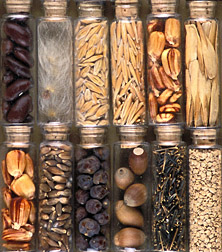Read the
magazine
story to find out more.
|

Seeds can still reveal genetic information even
after they will no longer germinate, offering the hope of obtaining usable DNA
even from 100-year-old seeds. Click the image for more information about
it.
|

|
Nonviable Seeds May Contain Research-Quality DNA
By Laura
McGinnis
August 11, 2008 Agricultural Research Service (ARS)
scientists in Fort Collins, Colo., have ways of making seeds talk. They have
demonstrated that seeds can reveal genetic information even after they've lost
viability, which is the ability to germinate. The research has significant
implications for seed bank management.
The research was conducted by plant physiologist
Christina
Walters, plant physiologist
Gayle
M. Volk and plant geneticist
Christopher
M. Richards at the ARS
National
Center for Genetic Resources Preservation (NCGRP) in Fort Collins, Colo.
Like all genebanks, the NCGRP stores genetic materials that researchers can
use to study the nature, function and evolution of genes. All seeds lose
viability in storage, however, and samples that can no longer germinate are
often discarded. But new research shows that even low-viability seeds can
contain research-quality DNA.
The ARS scientists examined three sets of seeds, ranging in age from one
year to 135 years. They were able to extract usable DNA from all of the
seeds—even the oldest set, which had been stored in a Georgia attic since
the Civil War.
This is significant because donated collections, such as the Civil War seeds
used in this study, are sometimes infested with microbes that contain enzymes
capable of degrading the seeds' DNA. Fortunately, genetic materials at the
NCGRP are stored under optimal conditions, and are at lower risk for
degradation.
Because the oldest seeds in this study are no longer capable of germinating,
the scientists have no means of measuring their phenotypes, or observable
genetic traits. However, stable DNA enables researchers to study the parent
plants' genetic material and uncover information about their genetic diversity.
Read
more about this research in the August 2008 issue of Agricultural
Research magazine.
ARS is a scientific research agency of the U.S. Department of Agriculture.